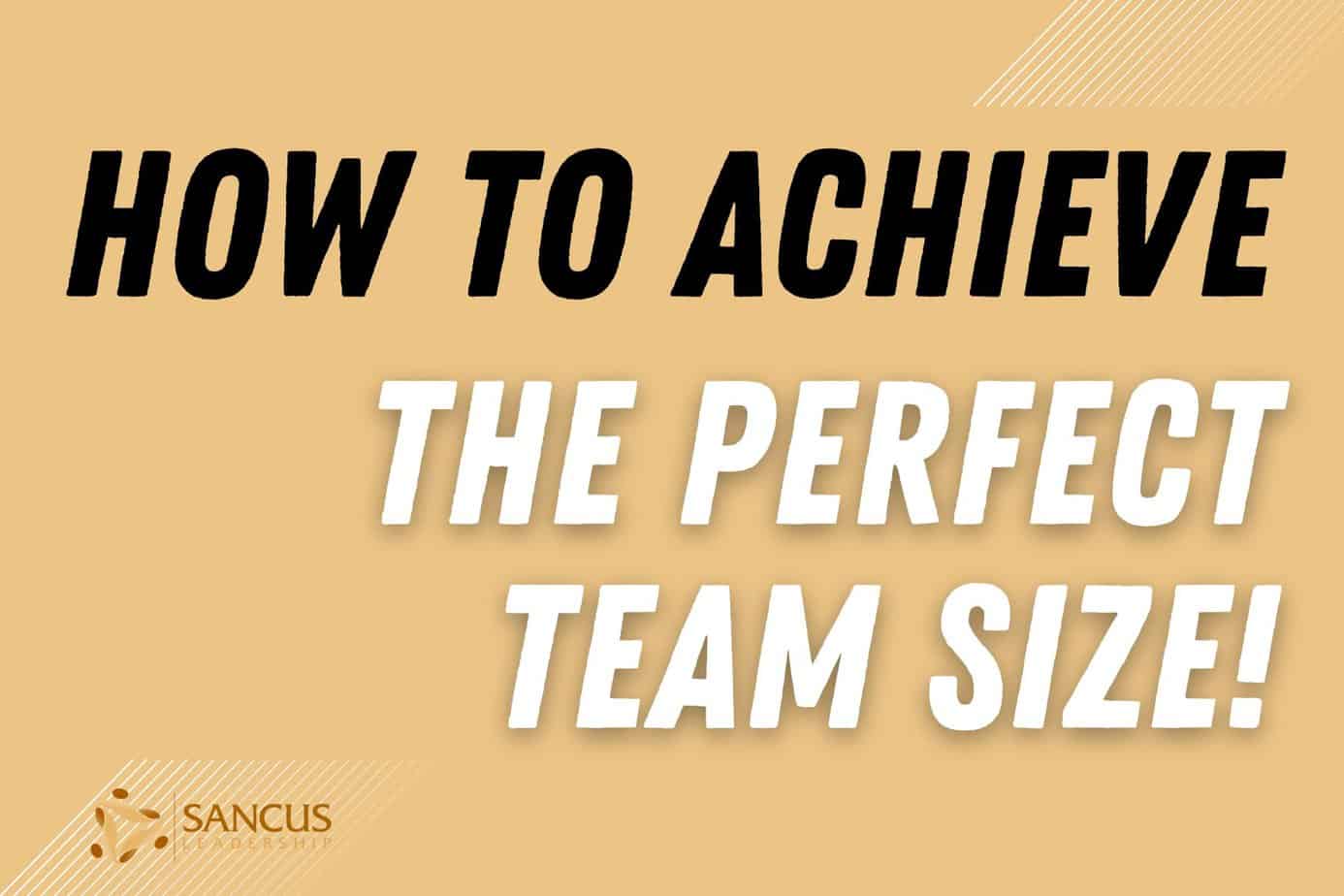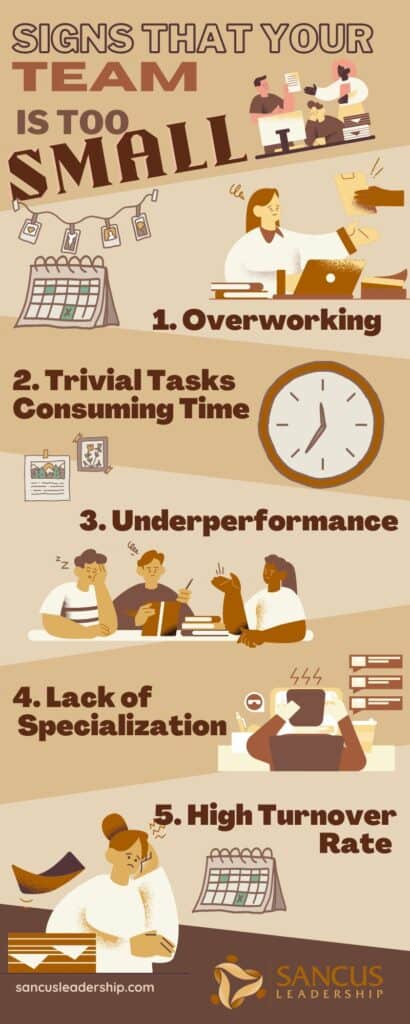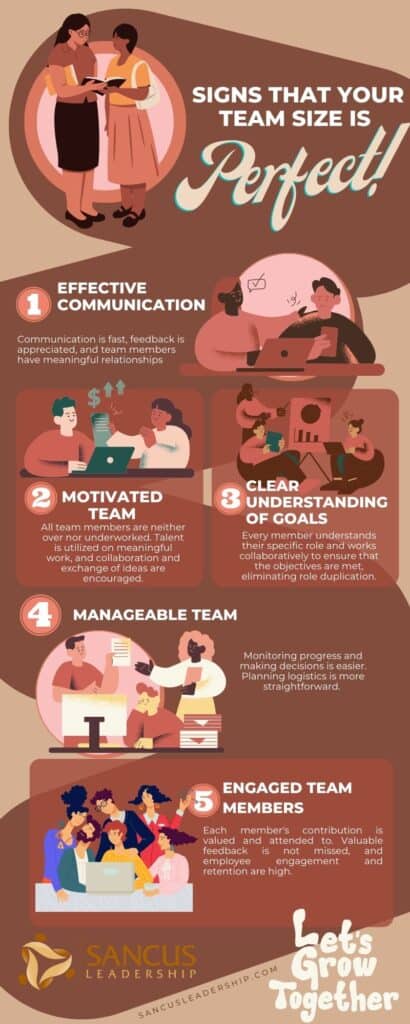Your cart is currently empty!

15 Hints That Your Team Size Needs To Change!
During my more than twelve years in leadership positions, I have been in charge of small bomb disposal teams of six and larger HR groups of thirty. One BIG mistake I made was to lead large and small teams in the same way. It took me years to fully understand how the size of a team impacts effectiveness and productivity;
A team of the wrong size will struggle with coordination, low employee engagement, and a slow decision-making process. Furthermore, team members risk being over or underworked. So what indicators should you look out for?
As you read, you will learn more about managing your team size. I will delve into related topics, such as how to know whether your team is a perfect size. You will also discover the impact that your team’s size has on the productivity and effectiveness of the team and how to maximize these factors as a team leader.
Signs That Your Team Is Too Large

Sometimes we think that having more people in a team gets more work done in less time. Unfortunately, this is only true sometimes. Larger groups require different ways of managing, which can overwhelm the team leader.
Other disadvantages of a large group include the following:
- It takes longer to engage all team members, especially where each individual’s feedback is required.
- Training a large team also requires more time and resources.
- Team members may contribute less effort to tasks (some members may get away with doing very little and riding on the hard work of others).
- Research has shown that productivity decreases as the group size increases and people are more productive when working alone than as a group (The Ringelmann Effect vs. The Social Loafing Effect).
- Making unanimous decisions is also much more complicated than smaller teams.
- Less talkative or introverted team members may be overshadowed by their counterparts.
- Communication is more complex with more points of contact, and it is harder to communicate effectively with everyone.
- Some team members may segregate themselves into cliques, which can weaken unity and trust in the team.
So, what are some pointers that your team is too large?
1. Coordination Is Overwhelming

If assigning tasks and monitoring each team member’s progress has become overwhelming, then you need to cut down on the size of your team.
As a team leader, you shouldn’t micromanage every last detail of each team member’s work. However, you should coordinate your team and monitor each individual’s progress without feeling overwhelmed.
You should coordinate your team and monitor each individual’s progress without feeling overwhelmed.
Another solution to this problem is to add a “2ic” or second in command as we call it in the army, someone that can support your leadership and follow up delegated tasks to your standard.
Most often, this person gets her own “arena,” such as logistics or training. But, if your company is like most other businesses I have seen, it’s probably not willing to invest in hiring or promoting someone to such a position.
If you cannot get someone to help you, your team size most likely needs to change.
2. The Team Project Entails Complex or Specialized Work
Larger teams are best suited for simple, repetitive tasks such as data entry. When work becomes more complex or specialized, it would be best to form smaller teams (you may also split a larger group into smaller units).
This is because specialized work requires more collaboration and coordination, which is very difficult to do with a large team.
3. Engaging Every Team Member Is Time-Consuming
When you realize that engaging every team member wastes too much time, your team is too big.
Effective teamwork requires each team member to contribute equally toward the common goal. Therefore, engaging each team member is crucial to a successful team. With this, you may fully utilize your team members’ ideas and resources, which could boost productivity.
Sometimes we are unlucky, and more team members need support than we have the time to mentor; this is unfortunate but quite common on large teams, especially if the tasks are complex and people are new.
Sometimes we are unlucky, and more team members need support than we have the time to mentor; …
Most companies try to get around this by scaling their training through online courses; sometimes, this works pretty well. But once again, if the task is complex with a lot of “moving parts,” you’ll quickly struggle to get your team to perform.
4. Decision-Making Is Challenging
Making unanimous decisions becomes increasingly tricky as team size grows. From trivial issues like when to have the next meeting to more complex matters, making unanimous decisions is more challenging with a large group.
This may leave the team leader with the role of making decisions on behalf of the team, which may seem dictatorial.
Team leaders of large teams tend to move towards a more directive leadership role, which isn’t necessarily bad or wrong but has a few shortcomings worth understanding.
You can read more about autocratic leadership here!
5. Team Members Aren’t Exerting Equal Effort
A common problem with large teams is that some members put in less effort than when working individually. This is called the ‘Social Loafing Effect.’ Together with the Rigelmann effect (the tendency of group members to do less as the group size grows), these phenomena help us understand that larger teams discourage full participation from all team members.
Here’s an interesting video of Dr. Jordan Peterson explaining who does all the work in a team;
So, when you notice some teammates slacking or having too much free time, it may mean that they are riding on the hard work of others.
In the army, we called it “shared responsibility is no one’s responsibility.”
“Shared responsibility is no one’s responsibility.”
This doesn’t mean you should immediately fire them; instead, now that you understand why this behavior exists, you can use it to the team’s advantage by speaking to the issue directly.
After you have made it clear who is in charge of what, and if you’re still struggling with social loafing, your team is most likely too big.
6. Some Roles Are Duplicated
When multiple people work on a role that just one person could have easily fulfilled, your team may be too big. Role duplication may also mean that your team needs more skill or talent variety (you may have recruited too many people with the same abilities).
Role duplication can reduce the productivity of a team. It consumes valuable team time and resources that could be used for more productive work.
7. Communication Is More Complicated
Communication in larger teams is complicated because there are increased lines of communication among team members. The team leader also has a more challenging time communicating with each team member individually and gathering their feedback promptly.
If you notice that information doesn’t reach the intended people or gets distorted too often, then it’s probably time to find better communication methods. Is it possible to have face-to-face meetings? Can you write this in a 300-word email?
Get feedback from employees on the lines of communication; how do they perceive the situation?
Remember that communication is two ways. The leader should be able to reach all members, and the members should also have a clear communication path with their leader.
A problem with large teams, let’s say twenty people, is that there would be nineteen lines of communication with the leader. Inevitably this means time spent communicating must be held at a minimum if you want to have time to do anything else.
And you can forget about “open doors” at the office if you want to be productive; there just isn’t enough time. If you’re still struggling with bad coms, then most likely, your team is too big.
Effective communication is a critical component of a successful team!
| Problem | Indicators | Solution |
| Overwhelming coordination | Micromanagement and monitoring are stressful | Add a second-in-command or reduce the size of the team |
| Complex or specialized work | Large teams are best for simple, repetitive tasks | Form smaller teams |
| Time-consuming engagement | Engaging every team member wastes too much time | Reduce team size |
| Challenging decision-making | Unanimous decisions become more difficult | The team leader may make decisions or form smaller teams |
| The unequal effort from team members | Some members put in less effort than working individually | Encourage full participation from all team members |
Signs That Your Team Is Too Small

Working in a smaller team has several benefits, such as better communication and more engagement from team members. However, when the group is too small, the members may experience several challenges that could have been averted by increasing the team’s size. Some of these challenges include the following:
1. Burnout Is Imminent
When the size of your team is not proportional to the amount of work that needs to be done, there is pressure on the team members to put in twice the effort to get the job done on time. This can lead to burnout or other forms of fatigue.
Increasing the team size isn’t a fix-all solution. As humans, we tend to stuff every free hour we get with tasks, so no matter how many people we are or how much time we have, we will find a way to fill our calendar.
Unchecked fatigue or burnout will kill your team’s overall productivity. Signs that your team is burnt out include the following:
- Dwindling motivation
- Lower work quality
- Poor concentration
- Less engagement from team members
- Frequent sickness
- Feeling physically and mentally tired.
- Displaced conflict
- Irritability
A much better way is to prioritize strictly, remove unnecessary appointments, tasks, and “fillers,” and focus on the 5% of inputs that give 80% of the benefits.
Burnout must be respected, so if you have prioritized strictly but still feel you or your team are at risk of falling ill, then it’s time to hire more people.
2. Trivial Tasks are Eating Up Valuable Time
Running office errands, data entry, and other basic tasks (but necessary) should not consume valuable time or talent. If these are eating into time for more impactful work, then you should consider adding one or two people to handle them.
When I struggle with too many tasks like this, I first ask myself: Can I automate this task? If not, then I outsource the problem to someone who can do it more efficiently (cheaper and faster).
If the answer is still no, my team or I must deal with it.
When high-value team members are caught up with basic work, the team misses out on their full potential because their time and talents are underused.
When high-value team members are caught up with basic work, the team misses out on their full potential because their time and talents are underused.
3. Underperformance: Not Meeting Targets
A small team may produce quality work, but there is only so much you can do with a limited number of people. If your team is underperforming and you have used the list above for troubleshooting, your team may be too lean.
Having more useful hands on deck helps the team achieve more and move closer to your targets; by useful, I mean qualified and properly trained personnel (in line with the discussed above).

Signs That Your Team Is Perfectly Sized

1. Communication Is Effective
Communication within the perfectly-sized team is fast and without “loss of substance”; below are some reasons why:
- There is sufficient time to interact with each individual.
- Sharing feedback doesn’t take up too much time and is appreciated by the receiver.
- Open and honest communication is commonplace because team members want each other’s opinions.
- Team members have meaningful relationships in and out of the office.
- Lines of communication are understood and used with respect to people’s time.
Effective communication is a norm when the unit is neither too small nor too big.
2. Your Team Is Motivated
When your team is just the right size, none of the members is over or underworked. All the work that needs to be done is distributed in a deliberate way, and there is good collaboration and exchange of ideas. This makes a solid base for a motivated team.
When your team is just the right size, none of the members is over or underworked.
Additionally, talent could be better-spent on menial errands. The team members usually direct their time and skills toward producing meaningful work, which motivates them to do better.
3. Everyone Understands the Goal
In a well-sized team, every member understands their specific role and works at it for the team’s greater success. The priorities are clear for each member, and they work collaboratively to ensure that the objectives are met. Role duplication is also eliminated when each member knows their responsibilities.
It is also possible for each team member to assume extra responsibilities since they have a good grasp of what is missing to reach the targets; this eliminates unnecessary communication and allows for a high-speed working environment.
4. The Team Is Manageable
As I mentioned earlier, a large team can be challenging to manage because of all the logistics involved. On the other hand, a perfectly-sized team is “smooth sailing.” Important management tasks such as monitoring progress and making decisions are easier to undertake.
It is also more straightforward to plan for the logistics of a perfectly sized team because of the ease of decision-making. Simple decisions, such as when and where to meet, can be a nightmare for larger groups.
5. All Team Members Are Engaged
In a team, every member counts (or at least should count). A correctly sized team allows for the engagement of all team members. Each member’s contribution is attentively listened to because it matters.
This way, the team does not miss out on valuable feedback from team members. It also helps their members communicate any challenges.

If you want to discover how I used "inner drive" to 3x the employee retention on my last team, book a free discovery call with me here!
How Does the Size of the Team Affect Team Effectiveness?

The type of work (complex or simple) and the need for efficiency (high or low) should dictate team size.
Relatively simple work that does not require unique skills can be done faster with a larger team (more than nine members). On the other hand, work that requires special skills or collaboration with people of different skill sets is best done by a smaller unit (up to nine members).
Relatively simple work that does not require unique skills can be done faster with a larger team.
This study conducted to determine the effect of size and task type on performance showed increased dissatisfaction among the members. As the team size grew, so did the level of dissatisfaction among members. Team member satisfaction is vital to team success and effectiveness because it keeps them motivated even on those tough days.
According to the same study, team members are most satisfied in teams of two, but this is often not practical because of the amount of work that needs to be done. Nonetheless, keeping a group as small as possible significantly benefits its effectiveness.
How Does the Size of a Group Affect Its Productivity?

In business, productivity is defined as the ratio of output to input. When managing a team, the goal is always to have substantially more output than input (or high productivity).
As with effectiveness, a larger team’s productivity will increase if the tasks are relatively more straightforward and do not require much expertise. However, smaller groups are more productive when more knowledge and collaboration are needed.
This study on 329 work teams across for-profit and nonprofit groups reported that groups of between 3 and 6 members were the most productive. As the group became larger, its productivity declined.
The Ringelmann effect explains that as a team grows, its productivity and effectiveness decline. It also demonstrates that people are more productive when working alone. This is similar to the Social Loafing effect, which also explains that people do less when they are part of a group.
The Ringelmann effect explains that as a team grows, its productivity and effectiveness decline.
Overall, larger groups do not deliver increased effectiveness or productivity in complex tasks requiring more collaboration.
